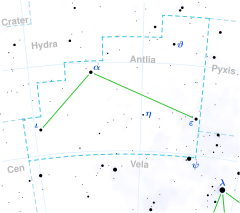| Observation data Epoch J2000 Equinox J2000 | |
|---|---|
| Constellation | Antlia |
| Right ascension | 10h 29m 35.37844s[1] |
| Declination | –30° 36′ 25.4413″[1] |
| Apparent magnitude (V) | +5.55[2] (5.58/9.65)[3] |
| Characteristics | |
| Spectral type | B9.5 V + F9 Ve[3] |
| U−B color index | –0.18[2] |
| B−V color index | –0.04[2] |
| Astrometry | |
| Radial velocity (Rv) | +14[4] km/s |
| Proper motion (μ) | RA: –32.512 ± 0.387[5] mas/yr Dec.: +0.918 ± 0.318[5] mas/yr |
| Parallax (π) | 7.1868 ± 0.2204 mas[5] |
| Distance | 450 ± 10 ly (139 ± 4 pc) |
| Absolute magnitude (MV) | –0.37[6] |
| Details | |
| δ Ant A | |
| Mass | 3.35 ± 0.15[6] M☉ |
| Luminosity | 200[6] L☉ |
| Temperature | 11,117[6] K |
| Rotational velocity (v sin i) | 27[7] km/s |
| Age | 214[6] Myr |
| Other designations | |
| Database references | |
| SIMBAD | data |
Delta Antliae (δ Ant, δ Antliae) is the Bayer designation for a binary star[6] system in the southern constellation of Antlia. The combined apparent visual magnitude of the system is +5.57,[2] allowing it to be viewed from the suburbs with the naked eye. Judging by the parallax shift of this system, it is located at a distance of 450 ± 10 light-years from Earth.[5] The system is reduced in magnitude by 0.03 due to extinction caused by intervening gas and dust.[3]
The primary component of the system has a stellar classification of B9.5 V, indicating that it is a B-type main sequence star. The companion is an F-type main sequence star with a classification of F9 Ve, where the 'e' indicates that there are emission lines in the spectrum. The two stars are separated by 11 arcseconds.[3]
Delta Antliae A, the brighter member of this system, has an estimated 3.4[6] times the mass of the Sun. It is radiating around 200[6] times as much luminosity as the Sun from its outer atmosphere at an effective temperature of 11,117 K.[6] At this heat, it shines with the characteristic blue-white hue of a B-type star.[8]
References[edit]
- ^ a b van Leeuwen, F. (November 2007), "Validation of the new Hipparcos reduction", Astronomy and Astrophysics, 474 (2): 653–664, arXiv:0708.1752, Bibcode:2007A&A...474..653V, doi:10.1051/0004-6361:20078357, S2CID 18759600.
- ^ a b c d Hurly, P. R. (1975), "Combined-light UBV Photometry of 103 Bright Southern Visual Doubles", Monthly Notes of the Astronomical Society of Southern Africa, 34: 7, Bibcode:1975MNSSA..34....7H.
- ^ a b c d Huélamo, N.; et al. (July 2000), "X-ray emission from Lindroos binary systems", Astronomy and Astrophysics, 359: 227–241, arXiv:astro-ph/0005348, Bibcode:2000A&A...359..227H.
- ^ Evans, D. S. (June 20–24, 1966), "The Revision of the General Catalogue of Radial Velocities", in Batten, Alan Henry; Heard, John Frederick (eds.), Determination of Radial Velocities and their Applications, Proceedings from IAU Symposium no. 30, vol. 30, University of Toronto: International Astronomical Union, p. 57, Bibcode:1967IAUS...30...57E.
- ^ a b c d Brown, A. G. A.; et al. (Gaia collaboration) (August 2018). "Gaia Data Release 2: Summary of the contents and survey properties". Astronomy & Astrophysics. 616. A1. arXiv:1804.09365. Bibcode:2018A&A...616A...1G. doi:10.1051/0004-6361/201833051. Gaia DR2 record for this source at VizieR.
- ^ a b c d e f g h i Hubrig, S.; et al. (June 2001), "Search for low-mass PMS companions around X-ray selected late B stars", Astronomy and Astrophysics, 372: 152–164, arXiv:astro-ph/0103201, Bibcode:2001A&A...372..152H, doi:10.1051/0004-6361:20010452, S2CID 17507782.
- ^ Royer, F.; Zorec, J.; Gómez, A. E. (February 2007), "Rotational velocities of A-type stars. III. Velocity distributions", Astronomy and Astrophysics, 463 (2): 671–682, arXiv:astro-ph/0610785, Bibcode:2007A&A...463..671R, doi:10.1051/0004-6361:20065224, S2CID 18475298.
- ^ "The Colour of Stars", Australia Telescope, Outreach and Education, Commonwealth Scientific and Industrial Research Organisation, December 21, 2004, archived from the original on 2012-03-18, retrieved 2012-01-16.

Well, that’s interesting to know that Psilotum nudum are known as whisk ferns. Psilotum nudum is the commoner species of the two. While the P. flaccidum is a rare species and is found in the tropical islands. Both the species are usually epiphytic in habit and grow upon tree ferns. These species may also be terrestrial and grow in humus or in the crevices of the rocks.
View the detailed Guide of Psilotum nudum: Detailed Study Of Psilotum Nudum (Whisk Fern), Classification, Anatomy, Reproduction